Inequality within Children Assignment
VerifiedAdded on 2021/01/14
|9
|2311
|45
AI Summary
Contribute Materials
Your contribution can guide someone’s learning journey. Share your
documents today.
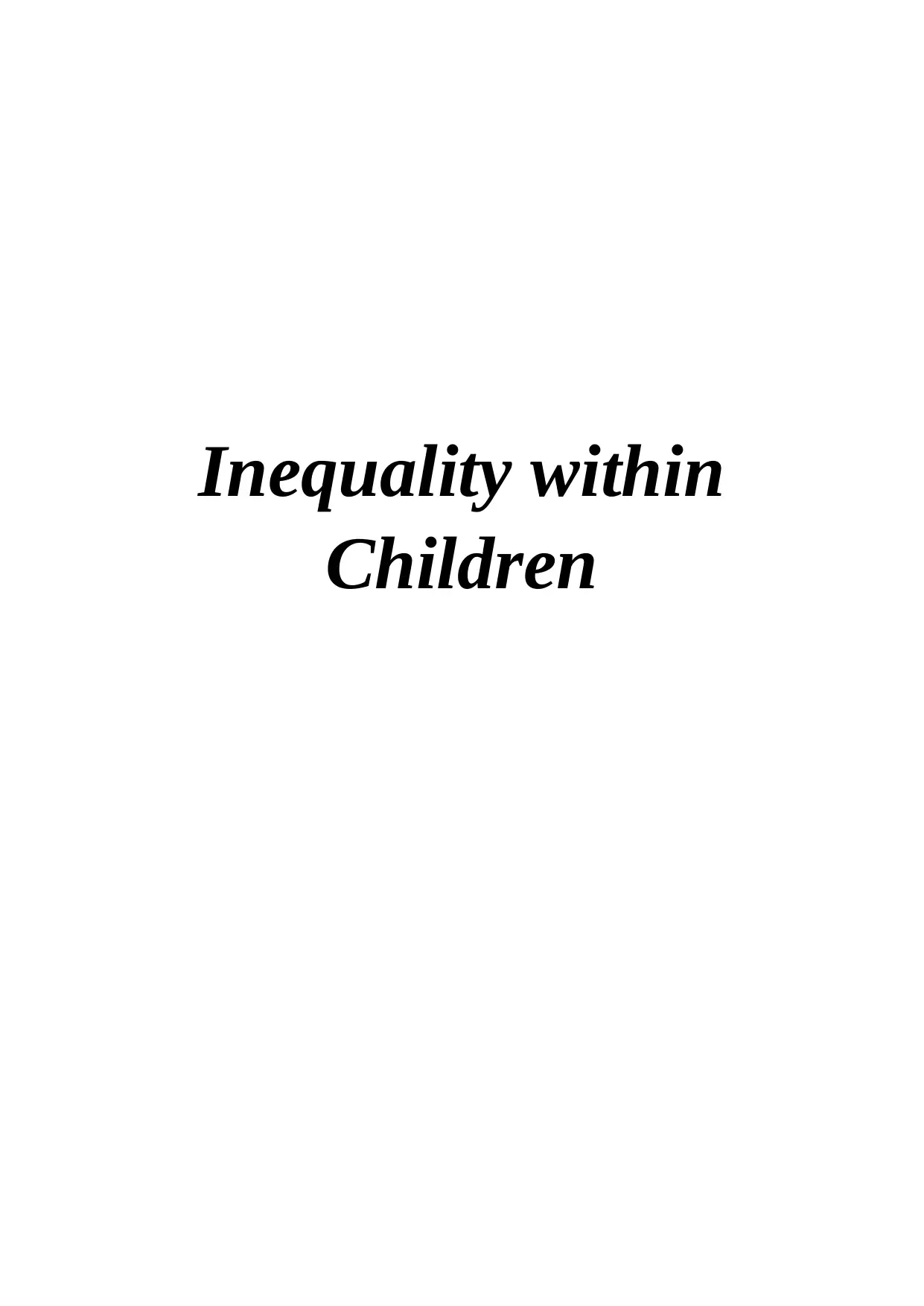
Inequality within
Children
Children
Secure Best Marks with AI Grader
Need help grading? Try our AI Grader for instant feedback on your assignments.
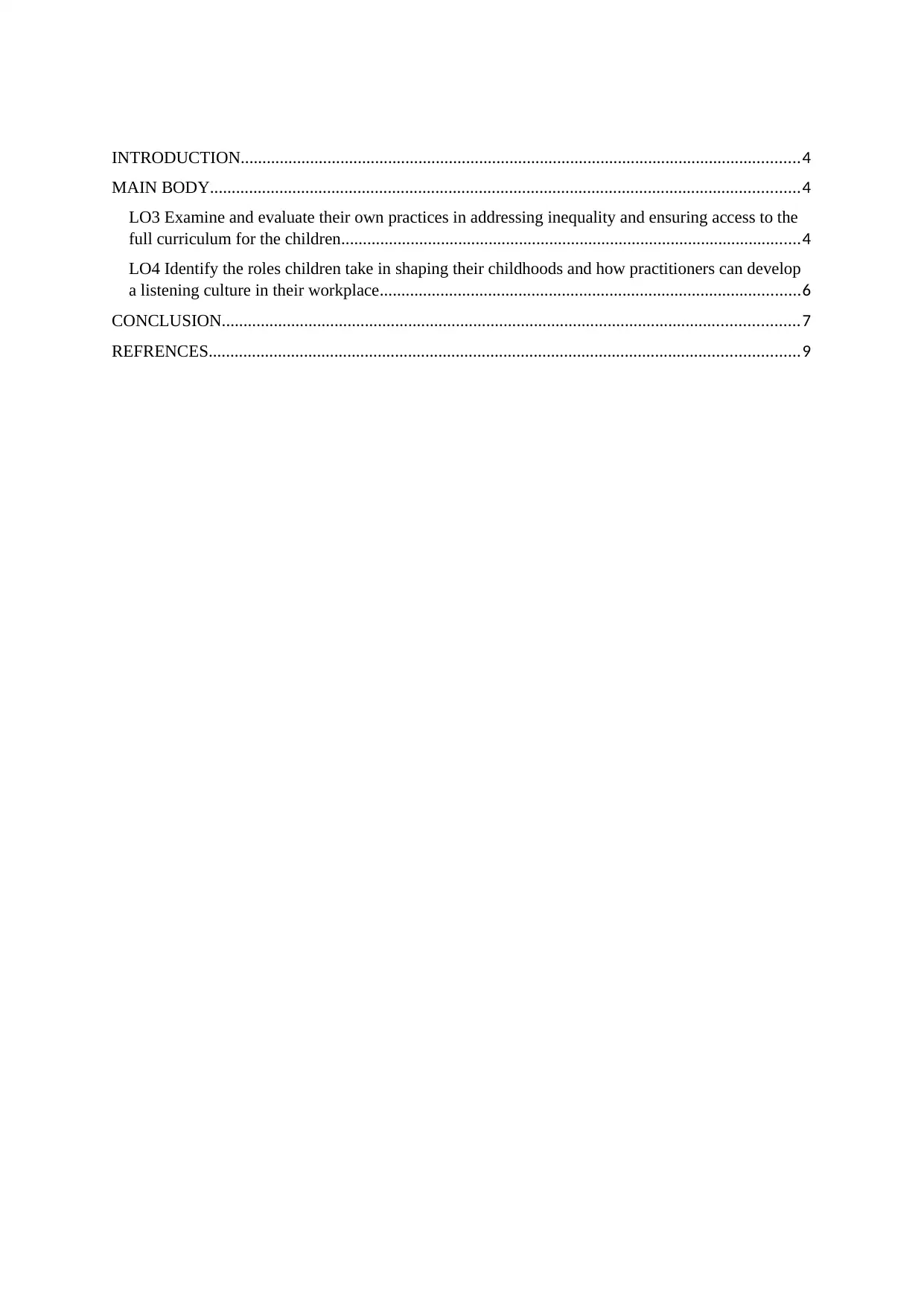
INTRODUCTION.................................................................................................................................4
MAIN BODY........................................................................................................................................4
LO3 Examine and evaluate their own practices in addressing inequality and ensuring access to the
full curriculum for the children..........................................................................................................4
LO4 Identify the roles children take in shaping their childhoods and how practitioners can develop
a listening culture in their workplace.................................................................................................6
CONCLUSION.....................................................................................................................................7
REFRENCES........................................................................................................................................9
MAIN BODY........................................................................................................................................4
LO3 Examine and evaluate their own practices in addressing inequality and ensuring access to the
full curriculum for the children..........................................................................................................4
LO4 Identify the roles children take in shaping their childhoods and how practitioners can develop
a listening culture in their workplace.................................................................................................6
CONCLUSION.....................................................................................................................................7
REFRENCES........................................................................................................................................9

INTRODUCTION
Inequality is the term which directly reflects unequal practices done with particular
person in terms of culture, colour, cast, physical disability and so on. Inequality within
children directly means not giving equal treatment to student within education institutions
(Entwisle, 2018). It takes place due to culture, cast, disability, family background of children
and many more. This assignment is based on the inequality within children and it will going
to discuss own practices in addressing inequality as well as make sure full curriculum for the
children. Along with this, role of children take in shaping their childhood and how
practitioners will develop listening culture within workplace.
MAIN BODY
LO3 Examine and evaluate their own practices in addressing inequality and ensuring access
to the full curriculum for the children
Inequality is the major issue which should be resolved in proper manner because if it
take place with children then give negative impact on mind for lifetime. Mainly inequality
takes place because of culture, cast, colour, background of family and many more. All such
make behaviour of children same because what they learn in childhood same practices will be
conduct by them in future (Capurro and et.al., 2015). Apart from all this one of the major
reasons behind inequality is race and culture because within educational institutions as well
as other places children are from different culture and have colour difference also.
Under equal status Acts 2000-2012 discrimination in the supply of goods and
provision of services is prohibited on the basis on nine elements such as: Gender, race, age
disability, traveller community, religion, sexual orientation, family and civil status and
disability terminology (Grabka, Marcus and Sierminska, 2015). In simple terms, children
have right no matter what they are who they are, where they live, what their parents do, what
language they speak, what their religion is, whether they are girl or boy, what their culture is,
whether they are rich or poor and so on. It is important not to treat child on the basis of these
unfairly.
As per the views of Alison Clark, it has been analysed that children who are attending school
have different perspectives rich child are viewing things in school with some different nature
and it will get change with the status of children (Kleven, Landais and Søgaard, 2018). There
Inequality is the term which directly reflects unequal practices done with particular
person in terms of culture, colour, cast, physical disability and so on. Inequality within
children directly means not giving equal treatment to student within education institutions
(Entwisle, 2018). It takes place due to culture, cast, disability, family background of children
and many more. This assignment is based on the inequality within children and it will going
to discuss own practices in addressing inequality as well as make sure full curriculum for the
children. Along with this, role of children take in shaping their childhood and how
practitioners will develop listening culture within workplace.
MAIN BODY
LO3 Examine and evaluate their own practices in addressing inequality and ensuring access
to the full curriculum for the children
Inequality is the major issue which should be resolved in proper manner because if it
take place with children then give negative impact on mind for lifetime. Mainly inequality
takes place because of culture, cast, colour, background of family and many more. All such
make behaviour of children same because what they learn in childhood same practices will be
conduct by them in future (Capurro and et.al., 2015). Apart from all this one of the major
reasons behind inequality is race and culture because within educational institutions as well
as other places children are from different culture and have colour difference also.
Under equal status Acts 2000-2012 discrimination in the supply of goods and
provision of services is prohibited on the basis on nine elements such as: Gender, race, age
disability, traveller community, religion, sexual orientation, family and civil status and
disability terminology (Grabka, Marcus and Sierminska, 2015). In simple terms, children
have right no matter what they are who they are, where they live, what their parents do, what
language they speak, what their religion is, whether they are girl or boy, what their culture is,
whether they are rich or poor and so on. It is important not to treat child on the basis of these
unfairly.
As per the views of Alison Clark, it has been analysed that children who are attending school
have different perspectives rich child are viewing things in school with some different nature
and it will get change with the status of children (Kleven, Landais and Søgaard, 2018). There
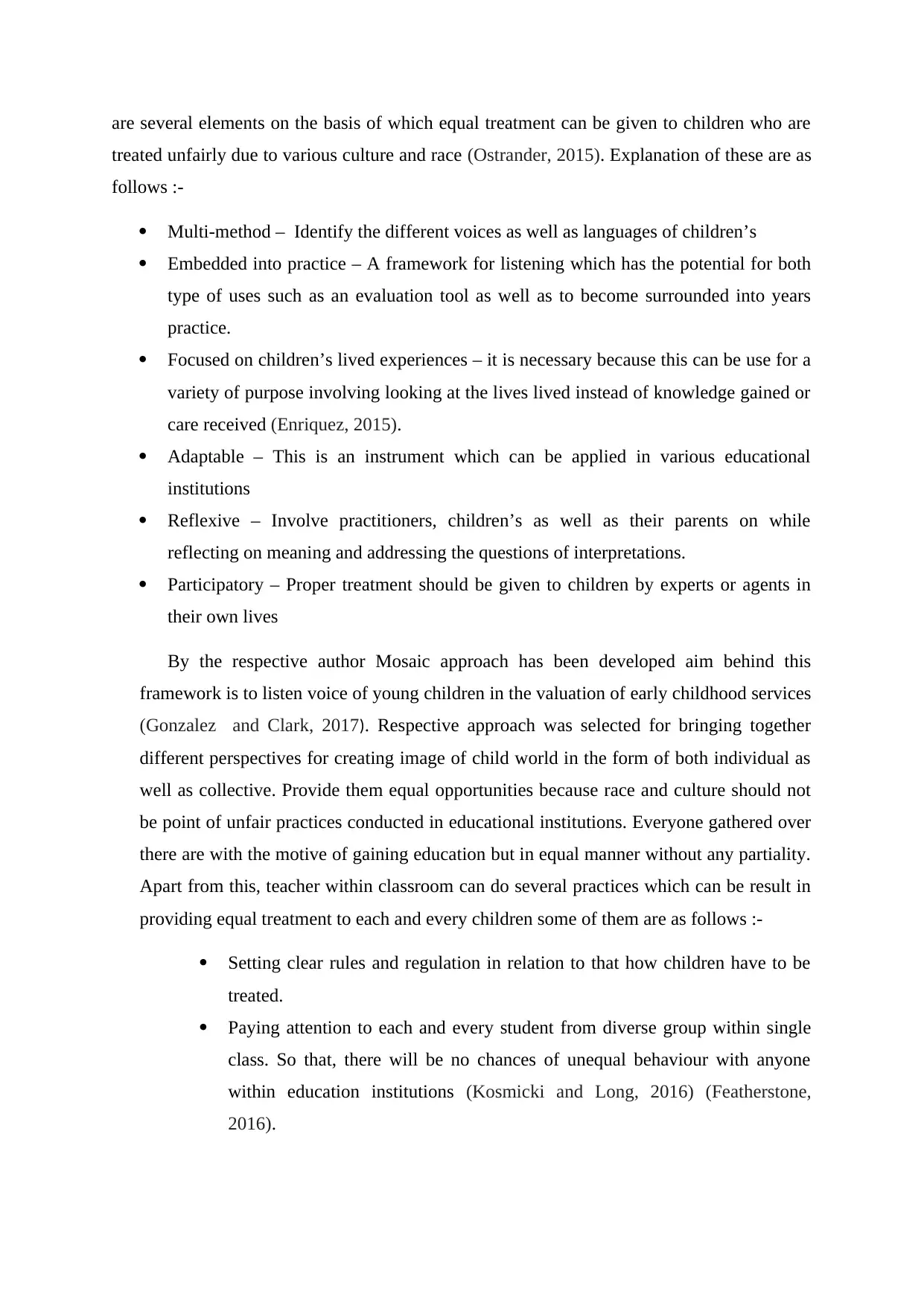
are several elements on the basis of which equal treatment can be given to children who are
treated unfairly due to various culture and race (Ostrander, 2015). Explanation of these are as
follows :-
Multi-method – Identify the different voices as well as languages of children’s
Embedded into practice – A framework for listening which has the potential for both
type of uses such as an evaluation tool as well as to become surrounded into years
practice.
Focused on children’s lived experiences – it is necessary because this can be use for a
variety of purpose involving looking at the lives lived instead of knowledge gained or
care received (Enriquez, 2015).
Adaptable – This is an instrument which can be applied in various educational
institutions
Reflexive – Involve practitioners, children’s as well as their parents on while
reflecting on meaning and addressing the questions of interpretations.
Participatory – Proper treatment should be given to children by experts or agents in
their own lives
By the respective author Mosaic approach has been developed aim behind this
framework is to listen voice of young children in the valuation of early childhood services
(Gonzalez and Clark, 2017). Respective approach was selected for bringing together
different perspectives for creating image of child world in the form of both individual as
well as collective. Provide them equal opportunities because race and culture should not
be point of unfair practices conducted in educational institutions. Everyone gathered over
there are with the motive of gaining education but in equal manner without any partiality.
Apart from this, teacher within classroom can do several practices which can be result in
providing equal treatment to each and every children some of them are as follows :-
Setting clear rules and regulation in relation to that how children have to be
treated.
Paying attention to each and every student from diverse group within single
class. So that, there will be no chances of unequal behaviour with anyone
within education institutions (Kosmicki and Long, 2016) (Featherstone,
2016).
treated unfairly due to various culture and race (Ostrander, 2015). Explanation of these are as
follows :-
Multi-method – Identify the different voices as well as languages of children’s
Embedded into practice – A framework for listening which has the potential for both
type of uses such as an evaluation tool as well as to become surrounded into years
practice.
Focused on children’s lived experiences – it is necessary because this can be use for a
variety of purpose involving looking at the lives lived instead of knowledge gained or
care received (Enriquez, 2015).
Adaptable – This is an instrument which can be applied in various educational
institutions
Reflexive – Involve practitioners, children’s as well as their parents on while
reflecting on meaning and addressing the questions of interpretations.
Participatory – Proper treatment should be given to children by experts or agents in
their own lives
By the respective author Mosaic approach has been developed aim behind this
framework is to listen voice of young children in the valuation of early childhood services
(Gonzalez and Clark, 2017). Respective approach was selected for bringing together
different perspectives for creating image of child world in the form of both individual as
well as collective. Provide them equal opportunities because race and culture should not
be point of unfair practices conducted in educational institutions. Everyone gathered over
there are with the motive of gaining education but in equal manner without any partiality.
Apart from this, teacher within classroom can do several practices which can be result in
providing equal treatment to each and every children some of them are as follows :-
Setting clear rules and regulation in relation to that how children have to be
treated.
Paying attention to each and every student from diverse group within single
class. So that, there will be no chances of unequal behaviour with anyone
within education institutions (Kosmicki and Long, 2016) (Featherstone,
2016).
Secure Best Marks with AI Grader
Need help grading? Try our AI Grader for instant feedback on your assignments.
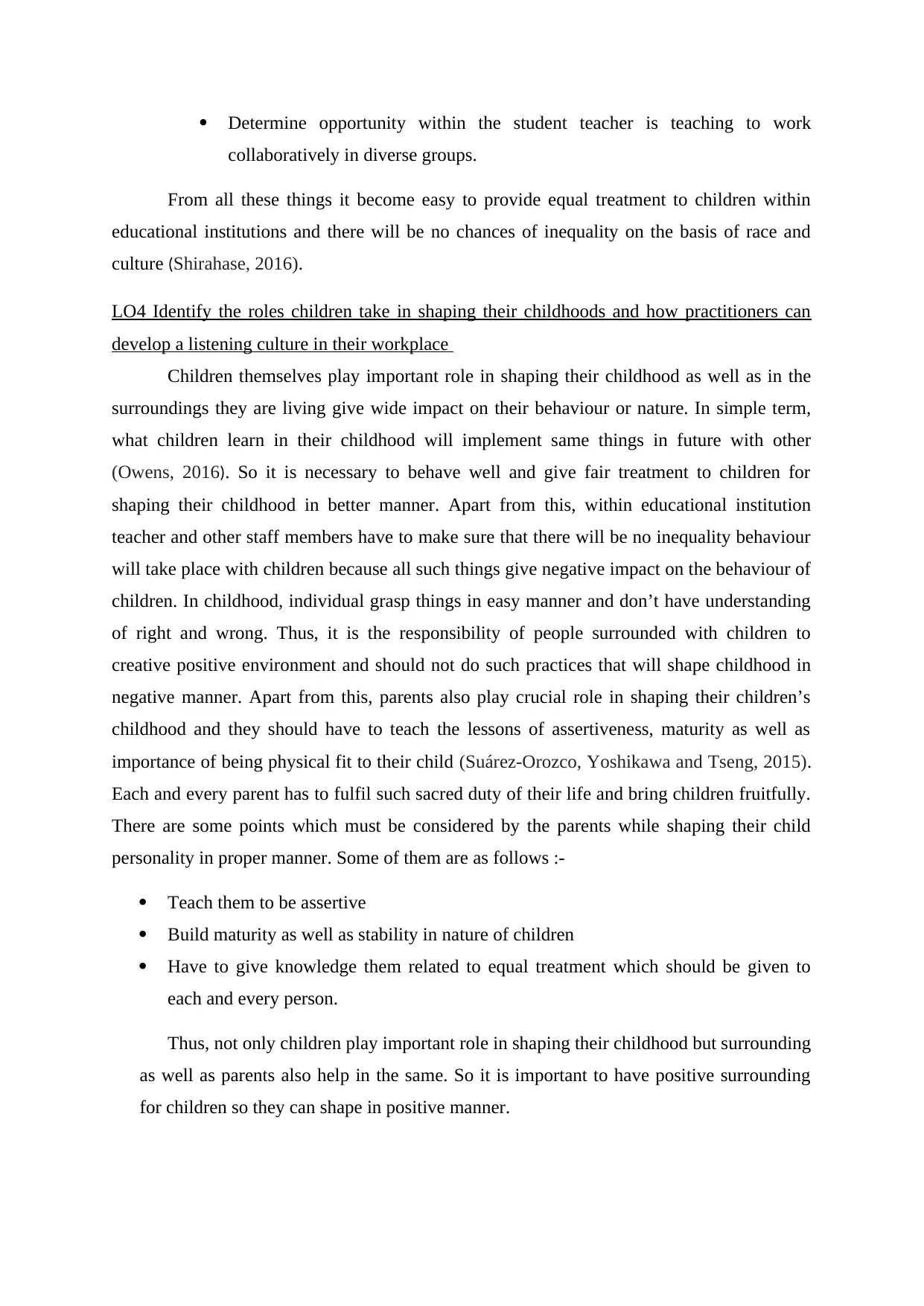
Determine opportunity within the student teacher is teaching to work
collaboratively in diverse groups.
From all these things it become easy to provide equal treatment to children within
educational institutions and there will be no chances of inequality on the basis of race and
culture (Shirahase, 2016).
LO4 Identify the roles children take in shaping their childhoods and how practitioners can
develop a listening culture in their workplace
Children themselves play important role in shaping their childhood as well as in the
surroundings they are living give wide impact on their behaviour or nature. In simple term,
what children learn in their childhood will implement same things in future with other
(Owens, 2016). So it is necessary to behave well and give fair treatment to children for
shaping their childhood in better manner. Apart from this, within educational institution
teacher and other staff members have to make sure that there will be no inequality behaviour
will take place with children because all such things give negative impact on the behaviour of
children. In childhood, individual grasp things in easy manner and don’t have understanding
of right and wrong. Thus, it is the responsibility of people surrounded with children to
creative positive environment and should not do such practices that will shape childhood in
negative manner. Apart from this, parents also play crucial role in shaping their children’s
childhood and they should have to teach the lessons of assertiveness, maturity as well as
importance of being physical fit to their child (Suárez-Orozco, Yoshikawa and Tseng, 2015).
Each and every parent has to fulfil such sacred duty of their life and bring children fruitfully.
There are some points which must be considered by the parents while shaping their child
personality in proper manner. Some of them are as follows :-
Teach them to be assertive
Build maturity as well as stability in nature of children
Have to give knowledge them related to equal treatment which should be given to
each and every person.
Thus, not only children play important role in shaping their childhood but surrounding
as well as parents also help in the same. So it is important to have positive surrounding
for children so they can shape in positive manner.
collaboratively in diverse groups.
From all these things it become easy to provide equal treatment to children within
educational institutions and there will be no chances of inequality on the basis of race and
culture (Shirahase, 2016).
LO4 Identify the roles children take in shaping their childhoods and how practitioners can
develop a listening culture in their workplace
Children themselves play important role in shaping their childhood as well as in the
surroundings they are living give wide impact on their behaviour or nature. In simple term,
what children learn in their childhood will implement same things in future with other
(Owens, 2016). So it is necessary to behave well and give fair treatment to children for
shaping their childhood in better manner. Apart from this, within educational institution
teacher and other staff members have to make sure that there will be no inequality behaviour
will take place with children because all such things give negative impact on the behaviour of
children. In childhood, individual grasp things in easy manner and don’t have understanding
of right and wrong. Thus, it is the responsibility of people surrounded with children to
creative positive environment and should not do such practices that will shape childhood in
negative manner. Apart from this, parents also play crucial role in shaping their children’s
childhood and they should have to teach the lessons of assertiveness, maturity as well as
importance of being physical fit to their child (Suárez-Orozco, Yoshikawa and Tseng, 2015).
Each and every parent has to fulfil such sacred duty of their life and bring children fruitfully.
There are some points which must be considered by the parents while shaping their child
personality in proper manner. Some of them are as follows :-
Teach them to be assertive
Build maturity as well as stability in nature of children
Have to give knowledge them related to equal treatment which should be given to
each and every person.
Thus, not only children play important role in shaping their childhood but surrounding
as well as parents also help in the same. So it is important to have positive surrounding
for children so they can shape in positive manner.

Along with this, educational institution and teachers also have wide impact on the
children behaviour (Montgomery, 2018). Because how they will be treated give wide
impact on behaviour of child. So it is important for teacher to not treat unfairly they have
to give equal treatment to each and every child. In addition to this, Practitioners should
have to implement equality act 2010, in their working so they can provide equal
opportunities to children within education institution. This act was introduced to offer
legal protection to each and every individual person (Elung’ata and et.al., 2017).
Protection characteristics are age, disability, race, sex, culture, family background and
many more. Apart from this, equality act is not only for children but also for the other
people working in the educational institutions and for their equality which is right of
every individual. There are several ways through which practitioners can develop
listening culture in their workings. Explanation of these are as follows :-
Motivate and encourage people to share their views and thoughts as well as
practitioners have to listen them actively because this practices result in increasing
future which is necessary for doing things in better manner within workplace (Vettore
and et.al., 2017 ).
Providing feedbacks related to particular activity result in building active listening
culture within workplace. Because feedbacks can be implemented only when things
are listen in effective manner as well as it will result in building active listening
culture within workplace.
From the above discussion it has been identified that all these practices result in
building listening culture within organisation that is necessary for sharing views and
thoughts of every individual working over their (Iglesias and Coelho, 2018). Apart from
this, in shaping childhood parents, children themselves, surrounding and teachers play
important. They have to build positive environment for children so that their will be good
shape of childhood as well as future of specific children.
CONCLUSION
From the above mention report, it has been concluded that inequality is the major
issues and should not done with anyone. If inequality will take place within children then this
may give negative impact on their mind statements as well as on their future practices also.
Apart from this, main reason behind inequality is race and cultural different of culture of
children behaviour (Montgomery, 2018). Because how they will be treated give wide
impact on behaviour of child. So it is important for teacher to not treat unfairly they have
to give equal treatment to each and every child. In addition to this, Practitioners should
have to implement equality act 2010, in their working so they can provide equal
opportunities to children within education institution. This act was introduced to offer
legal protection to each and every individual person (Elung’ata and et.al., 2017).
Protection characteristics are age, disability, race, sex, culture, family background and
many more. Apart from this, equality act is not only for children but also for the other
people working in the educational institutions and for their equality which is right of
every individual. There are several ways through which practitioners can develop
listening culture in their workings. Explanation of these are as follows :-
Motivate and encourage people to share their views and thoughts as well as
practitioners have to listen them actively because this practices result in increasing
future which is necessary for doing things in better manner within workplace (Vettore
and et.al., 2017 ).
Providing feedbacks related to particular activity result in building active listening
culture within workplace. Because feedbacks can be implemented only when things
are listen in effective manner as well as it will result in building active listening
culture within workplace.
From the above discussion it has been identified that all these practices result in
building listening culture within organisation that is necessary for sharing views and
thoughts of every individual working over their (Iglesias and Coelho, 2018). Apart from
this, in shaping childhood parents, children themselves, surrounding and teachers play
important. They have to build positive environment for children so that their will be good
shape of childhood as well as future of specific children.
CONCLUSION
From the above mention report, it has been concluded that inequality is the major
issues and should not done with anyone. If inequality will take place within children then this
may give negative impact on their mind statements as well as on their future practices also.
Apart from this, main reason behind inequality is race and cultural different of culture of
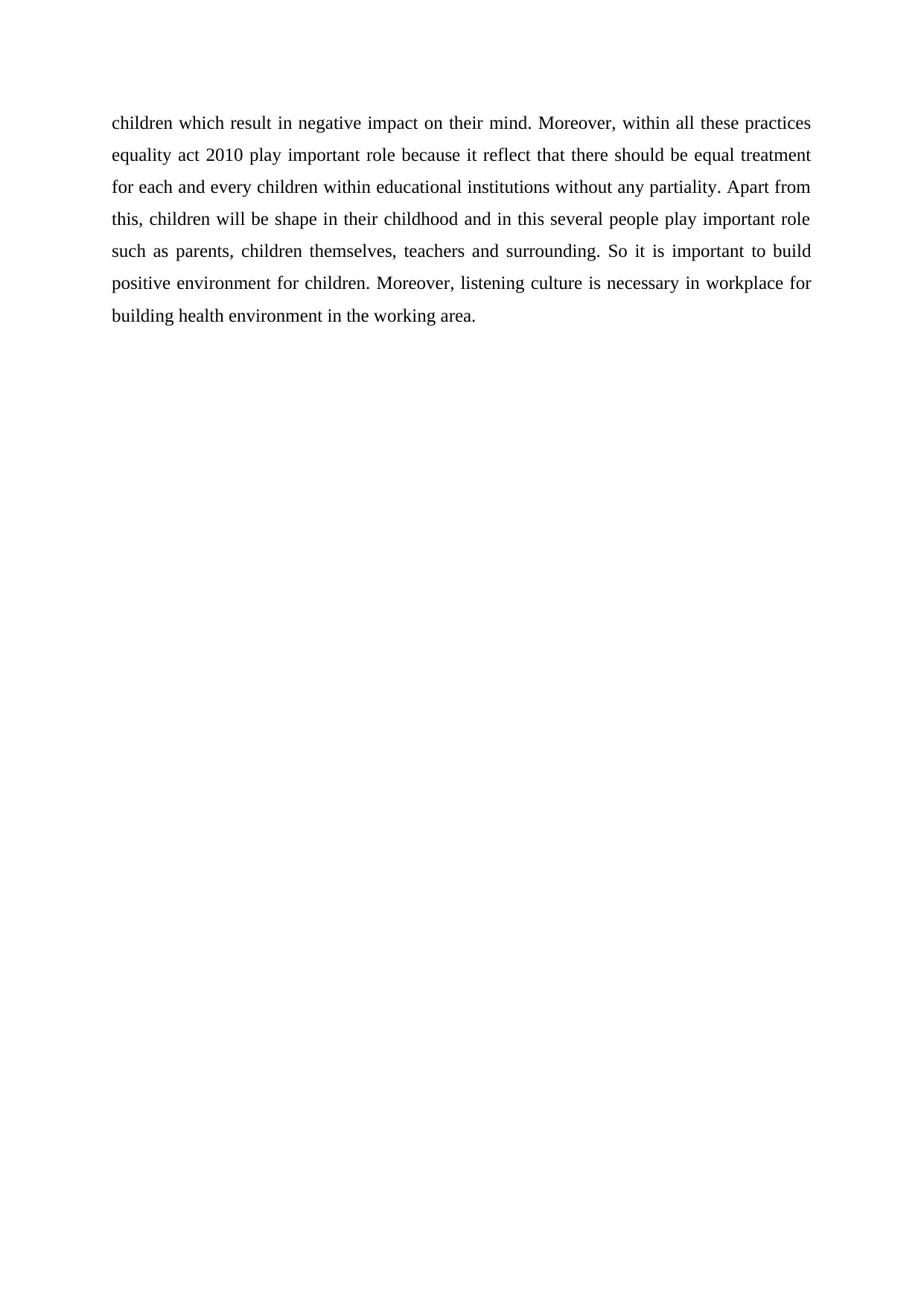
children which result in negative impact on their mind. Moreover, within all these practices
equality act 2010 play important role because it reflect that there should be equal treatment
for each and every children within educational institutions without any partiality. Apart from
this, children will be shape in their childhood and in this several people play important role
such as parents, children themselves, teachers and surrounding. So it is important to build
positive environment for children. Moreover, listening culture is necessary in workplace for
building health environment in the working area.
equality act 2010 play important role because it reflect that there should be equal treatment
for each and every children within educational institutions without any partiality. Apart from
this, children will be shape in their childhood and in this several people play important role
such as parents, children themselves, teachers and surrounding. So it is important to build
positive environment for children. Moreover, listening culture is necessary in workplace for
building health environment in the working area.
Paraphrase This Document
Need a fresh take? Get an instant paraphrase of this document with our AI Paraphraser
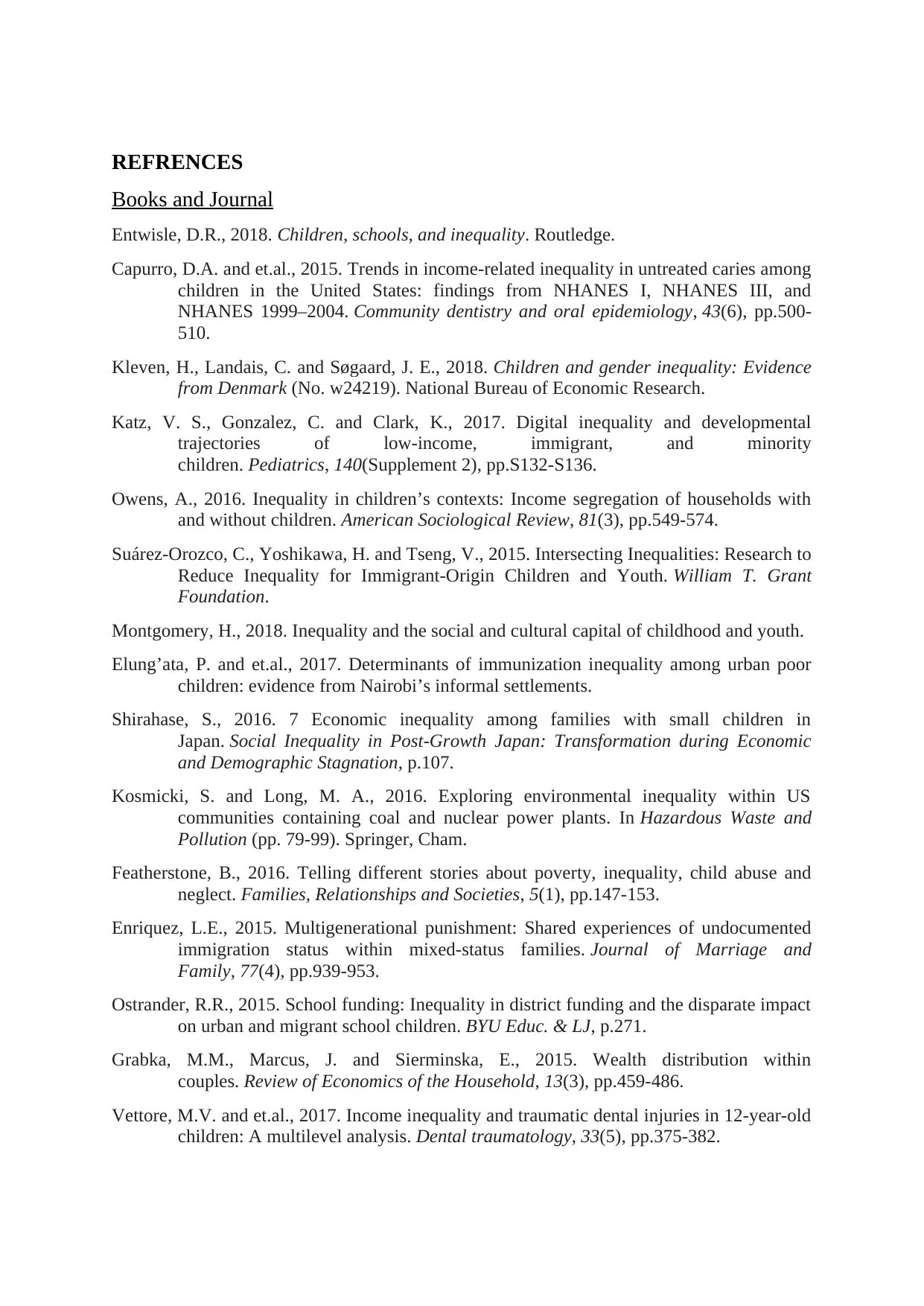
REFRENCES
Books and Journal
Entwisle, D.R., 2018. Children, schools, and inequality. Routledge.
Capurro, D.A. and et.al., 2015. Trends in income‐related inequality in untreated caries among
children in the United States: findings from NHANES I, NHANES III, and
NHANES 1999–2004. Community dentistry and oral epidemiology, 43(6), pp.500-
510.
Kleven, H., Landais, C. and Søgaard, J. E., 2018. Children and gender inequality: Evidence
from Denmark (No. w24219). National Bureau of Economic Research.
Katz, V. S., Gonzalez, C. and Clark, K., 2017. Digital inequality and developmental
trajectories of low-income, immigrant, and minority
children. Pediatrics, 140(Supplement 2), pp.S132-S136.
Owens, A., 2016. Inequality in children’s contexts: Income segregation of households with
and without children. American Sociological Review, 81(3), pp.549-574.
Suárez-Orozco, C., Yoshikawa, H. and Tseng, V., 2015. Intersecting Inequalities: Research to
Reduce Inequality for Immigrant-Origin Children and Youth. William T. Grant
Foundation.
Montgomery, H., 2018. Inequality and the social and cultural capital of childhood and youth.
Elung’ata, P. and et.al., 2017. Determinants of immunization inequality among urban poor
children: evidence from Nairobi’s informal settlements.
Shirahase, S., 2016. 7 Economic inequality among families with small children in
Japan. Social Inequality in Post-Growth Japan: Transformation during Economic
and Demographic Stagnation, p.107.
Kosmicki, S. and Long, M. A., 2016. Exploring environmental inequality within US
communities containing coal and nuclear power plants. In Hazardous Waste and
Pollution (pp. 79-99). Springer, Cham.
Featherstone, B., 2016. Telling different stories about poverty, inequality, child abuse and
neglect. Families, Relationships and Societies, 5(1), pp.147-153.
Enriquez, L.E., 2015. Multigenerational punishment: Shared experiences of undocumented
immigration status within mixed‐status families. Journal of Marriage and
Family, 77(4), pp.939-953.
Ostrander, R.R., 2015. School funding: Inequality in district funding and the disparate impact
on urban and migrant school children. BYU Educ. & LJ, p.271.
Grabka, M.M., Marcus, J. and Sierminska, E., 2015. Wealth distribution within
couples. Review of Economics of the Household, 13(3), pp.459-486.
Vettore, M.V. and et.al., 2017. Income inequality and traumatic dental injuries in 12‐year‐old
children: A multilevel analysis. Dental traumatology, 33(5), pp.375-382.
Books and Journal
Entwisle, D.R., 2018. Children, schools, and inequality. Routledge.
Capurro, D.A. and et.al., 2015. Trends in income‐related inequality in untreated caries among
children in the United States: findings from NHANES I, NHANES III, and
NHANES 1999–2004. Community dentistry and oral epidemiology, 43(6), pp.500-
510.
Kleven, H., Landais, C. and Søgaard, J. E., 2018. Children and gender inequality: Evidence
from Denmark (No. w24219). National Bureau of Economic Research.
Katz, V. S., Gonzalez, C. and Clark, K., 2017. Digital inequality and developmental
trajectories of low-income, immigrant, and minority
children. Pediatrics, 140(Supplement 2), pp.S132-S136.
Owens, A., 2016. Inequality in children’s contexts: Income segregation of households with
and without children. American Sociological Review, 81(3), pp.549-574.
Suárez-Orozco, C., Yoshikawa, H. and Tseng, V., 2015. Intersecting Inequalities: Research to
Reduce Inequality for Immigrant-Origin Children and Youth. William T. Grant
Foundation.
Montgomery, H., 2018. Inequality and the social and cultural capital of childhood and youth.
Elung’ata, P. and et.al., 2017. Determinants of immunization inequality among urban poor
children: evidence from Nairobi’s informal settlements.
Shirahase, S., 2016. 7 Economic inequality among families with small children in
Japan. Social Inequality in Post-Growth Japan: Transformation during Economic
and Demographic Stagnation, p.107.
Kosmicki, S. and Long, M. A., 2016. Exploring environmental inequality within US
communities containing coal and nuclear power plants. In Hazardous Waste and
Pollution (pp. 79-99). Springer, Cham.
Featherstone, B., 2016. Telling different stories about poverty, inequality, child abuse and
neglect. Families, Relationships and Societies, 5(1), pp.147-153.
Enriquez, L.E., 2015. Multigenerational punishment: Shared experiences of undocumented
immigration status within mixed‐status families. Journal of Marriage and
Family, 77(4), pp.939-953.
Ostrander, R.R., 2015. School funding: Inequality in district funding and the disparate impact
on urban and migrant school children. BYU Educ. & LJ, p.271.
Grabka, M.M., Marcus, J. and Sierminska, E., 2015. Wealth distribution within
couples. Review of Economics of the Household, 13(3), pp.459-486.
Vettore, M.V. and et.al., 2017. Income inequality and traumatic dental injuries in 12‐year‐old
children: A multilevel analysis. Dental traumatology, 33(5), pp.375-382.

Iglesias, W. J. and Coelho, A. B., 2018. Poverty and inequality within Brazilian households:
an application of a collective consumption model. Empirical Economics, pp.1-30.
an application of a collective consumption model. Empirical Economics, pp.1-30.
1 out of 9
Related Documents
Your All-in-One AI-Powered Toolkit for Academic Success.
+13062052269
info@desklib.com
Available 24*7 on WhatsApp / Email
![[object Object]](/_next/static/media/star-bottom.7253800d.svg)
Unlock your academic potential
© 2024 | Zucol Services PVT LTD | All rights reserved.




![Leading Organisational Equality and Diversity [pic]](/_next/image/?url=https%3A%2F%2Fdesklib.com%2Fmedia%2Fimages%2Fml%2Fc59cbbfb7c304fdba61f0e58a817eabd.jpg&w=256&q=75)
